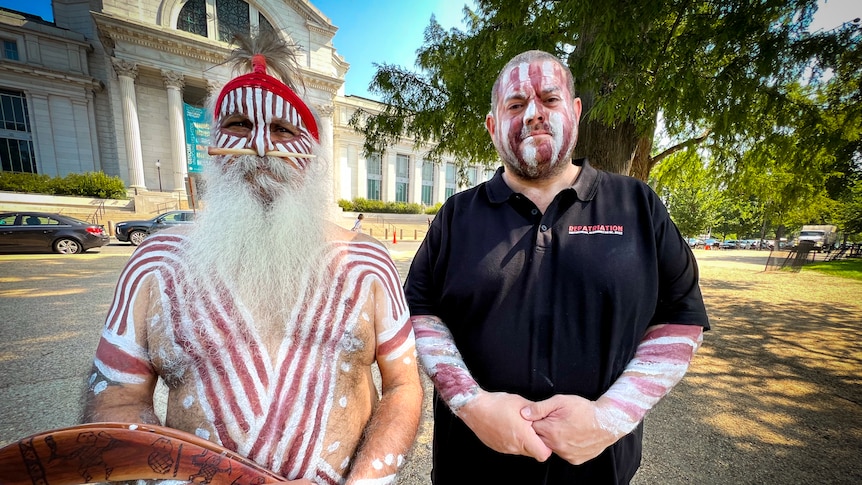Millions of people pass through the doors of one of America’s most popular museums each year.
But few come with a purpose as deeply personal as the group of Indigenous South Australians who recently arrived at the front steps.
WARNING: Aboriginal and Torres Strait Islander readers are advised that the following story contains images and voices of people who have died.
For decades, the Smithsonian National Museum of Natural History has held the remains of Aboriginal and Torres Strait Islander people whose bones were taken from Australia in order to be studied in the United States.
Major Sumner was one of several representatives from the Narungga and Kaurna nations who made the long journey to the US capital to take their ancestors home.
“Let the world know this is what happened to our people, to the people that passed on,” he said.
“They were taken away, they were put in boxes and kept in museums and poked.
“Once we rebury them, they [will] no longer be touched.”
A long history of ancestral remains taken from Indigenous land
The repatriation from Washington was the third time the Smithsonian Institution had returned ancestral remains to Australia.
It earlier repatriated bones taken from the Northern Territory during a major scientific expedition to Arnhem Land in 1948.
Co-sponsored by the Smithsonian, National Geographic and the Australian government, the months-long trip was carried out by a team of scientists, anthropologists and photographers from both Australia and the US.
Martin Thomas, a professor of history at the Australian National University, said the researchers collected thousands of plant and animal specimens, as well as Indigenous artifacts and paintings.
But they also took human remains, without the permission of traditional owners.
“With travel time, they were away for the better part of a year,” he said.
“And so the understanding was that they would come back with collections that would be the dividends on that investment.”
In his 2018 documentary Etched in Bone, Professor Thomas showcased footage taken during the expedition of American Frank Setzler removing remains from a cave at Gunbalanya.
The film cites Setzler’s diary entries to argue he deliberately hid what he was doing from the local Indigenous people.
“I paid no attention to these bones as long as the native was with me,” he wrote on October 7, 1948.
“During the lunch period, while the two native boys were asleep, I gathered the two skeletons which had been placed in crevices outside the caves.”
The remains stolen during the expedition were finally returned in 2008 and 2010.
“He was more an archaeologist than an anthropologist, so more interested in past eras, than contemporary cultures,” Professor Thomas said.
“And he wasn’t really somebody who was interested in documenting culture, particularly, even in his own field of specialisation, which was North American anthropology.
“He was much more of an excavator.”
Museum acknowledges long wait for Indigenous communities
The remains repatriated in July 2022 entered the Smithsonian’s collections between 1904 and 1931, before the expedition to Arnhem Land began.
The institution would not detail how it acquired them, referring only to “accessions” and “exchanges” with other museums.
The remains of two people have been returned to the Narungga and Kaurna nations in South Australia, while a further 23 will be held by the Australian Government until traditional custodians are determined.
“We realize as museums that we have to be part of the 21st century,” the National Museum of Natural History’s director Kirk Johnson said.
“And move towards repatriation of human remains and funerary objects, and with much more respect to the source communities from which these objects came.”
The repatriations to Australia are the result of years of lobbying from Indigenous leaders, with the Smithsonian having initially resisted the return.
That was despite laws being passed in the US in the 1990s requiring the repatriation, on request, of human remains and ancestral objects belonging to Native American people.
“When you take people off Country, you’re taking away their spirit,” Narungga man Cyril Kartinyeri said.
“And bringing them back to Country, then that’s their resting place.”
Mr Johnson acknowledged the long wait of Australian Indigenous communities, with one collection of ancestral remains still to be returned at an undecided date.
“We’re in communication with the Australian government and with the communities to make sure that we get these things going,” he said.
“Fast enough I’m sure is not fast enough for the communities, but we really want to be as responsive as possible.”
Remains to be reburied on Country
On a hot Washington summer’s day, the visiting Indigenous leaders carried two boxes containing ancestral remains, draped in the Aboriginal flag, into the gardens outside the museum.
Under the shade of a large tree, they performed a smoking ceremony and reflected on the significance of the task they were about to undertake.
“It’s an honor and a privilege to be here today, as we represent our nation groups,” Allan Sumner said.
“And to write our histories, according to us.”
The Kaurna, Ngarrindjeri and Yankunytjatjara man said the group had experienced mixed emotions while in the US but was hopeful of making a positive impact by taking the remains back for reburial.
“It’s not the most pleasant thing to do but it’s the right thing to do for us.
“This is about healing for ourselves, healing for our Country, and our people.”
Major Sumner had not been in Washington for long but was already looking ahead to the trip home.
“It’s going to be a joyful one. Because it’s their spirit, you can feel their spirits and feel them,” he said.
“I talk to them and tell them you’re going home now.
“We’ll get you there as fast as possible and get you back to where you came from.”
.
